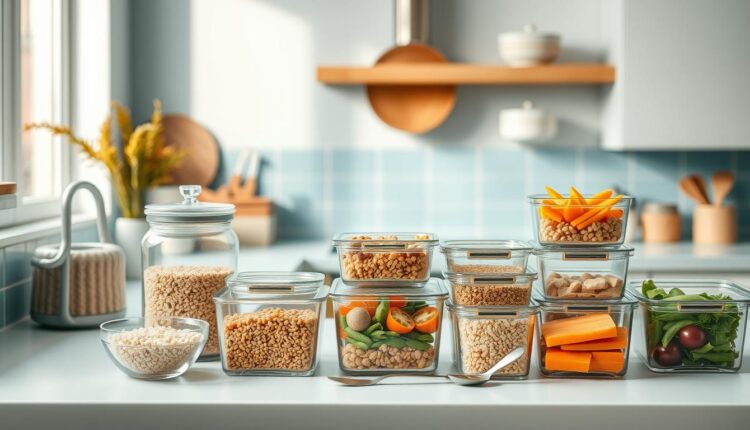High Protein Lunch Prep Component System Mix Match
Master the high protein lunch prep component system with our step-by-step guide. Learn to mix and match components for stress-free, healthy meals.
Three years ago, I stood in my Asheville kitchen staring at mismatched containers of roasted chicken and wilted greens. My twins needed lunches that could survive backpacks, while my partner craved meals that didn’t taste “assembled.” That’s when I discovered the power of strategic building blocks—versatile ingredients you prep once and remix all week.
This kitchen-tested approach lets you create satisfying midday meals without repeating flavors. Think of it like a puzzle: cooked grains, roasted veggies, and lean proteins become your foundation. Add sauces or spices to transform yesterday’s grilled turkey into today’s zesty wrap or tomorrow’s hearty salad.
- Design meals around your family’s tastes and schedule
- Reduce decision fatigue with smart ingredient overlaps
- Maintain nutritional balance without extra effort
I’ve seen this method help parents manage picky eaters, professionals power through afternoon slumps, and budget-conscious cooks minimize waste. You’ll find real-life solutions here—like how batch-cooking beans once fueled six different lunches—that respect your time and energy.
Overview of the High Protein Lunch Prep Component System
Last Tuesday, I watched a client stare into her fridge like it was a puzzle missing half its pieces. “I’m tired of scrambling every afternoon,” she sighed. That’s when I showed her how this method turns chaotic cooking into intentional fuel-building.
Understanding Meal Prep Benefits
Prepping core ingredients ahead cuts daily kitchen time by 40%, according to EatingWell’s freezer meal research. Imagine roasted sweet potatoes doing double duty in wraps and grain bowls. Or shredded chicken starring in tacos and salads. You’ll hit nutritional targets without reheating leftovers that taste… well, leftover.

Key Ingredients for Protein-Packed Meals
Focus on versatile stars: lentils (18g per cup), turkey breast (26g per serving), and marinated tofu. Pair them with flavor boosters like chimichurri or tahini drizzle. This mix-and-match breakfast formula works equally well for midday meals.
Balancing grams per portion keeps energy steady from lunch through evening commitments. One client dropped 8 pounds in two months simply by hitting her daily protein goals consistently—no drastic diet changes needed. Next, we’ll explore how to build your personalized blueprint using these principles.
The Benefits of Incorporating Protein into Your Lunch Prep
I once crashed hard after a client meeting, reaching for sugary snacks that left me hungrier. Registered dietitian Courtney Pelitera explains why: “Aim for 20-30 grams per serving—it stabilizes blood sugar better than quick carbs.” Strategic planning ensures you get that steady fuel without daily kitchen marathons.
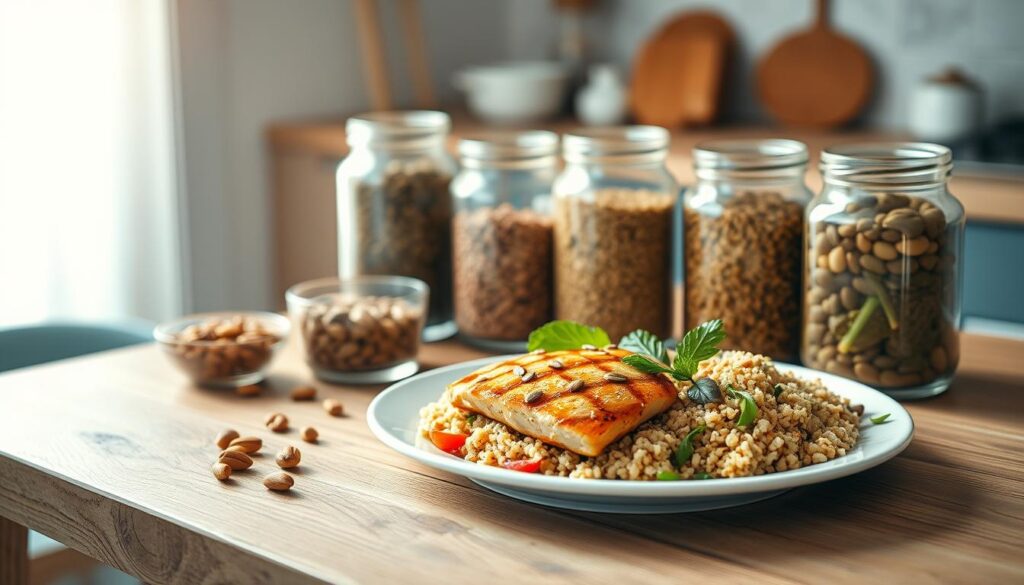
Why Your Body Thanks You
Balanced portions keep energy levels rock-solid. One parent told me her teen stopped raiding the snack drawer after school when their meals included measured chicken strips or marinated chickpeas. Muscles repair faster, too—a game-changer for gym regulars and weekend warriors alike.
Studies show menus built around quality sources (think salmon or lentils) naturally boost fiber and nutrient intake. One client’s dinner strategy? Cook extra grilled shrimp to toss into next-day grain bowls. This overlap cuts cooking time while hitting daily targets.
For those craving heat, our spicy variations prove you don’t need bland food to eat well. The key lies in smart prep: portion cooked meats into 4-ounce packs, or batch hard-boil eggs for grab-and-go salads. Your future self will thank you when 3 PM hunger strikes.
Building Your high protein lunch prep component system
Last month, a reader emailed me photos of her fridge—packed with ingredients but zero cohesive meals. Sound familiar? That’s when we built her first flexible blueprint using three core elements: foundation, flavor, and function.
Mix and Match: Components and Options
Start with foundation builders like shredded chicken (24g per serving) or black beans. One batch becomes burritos, salads, or stir-fries. My freezer stash always includes bean-and-cheese wraps—thaw one morning, and it’s lunch-ready by noon.
Next, choose flavor amplifiers. A tangy yogurt sauce transforms basic grains, while pickled veggies add crunch. Rotate these weekly to prevent taste bud boredom. One client uses the same grilled turkey in Greek bowls Monday and BBQ wraps Wednesday.
- Batch-cook 2-3 proteins (chicken thighs, lentils, tofu)
- Prep versatile veggies (roasted, raw, fermented)
- Create 1-2 sauces/dressings per week
Portion control matters. Use 4-ounce containers for proteins and ½-cup measures for grains. For weight management goals, track grams per meal using apps like MyFitnessPal. A viewer from our meal prep video series lost 12 pounds simply by adjusting her portions—no recipe changes needed.
Remember: Your plan should bend to your life. Swap chicken for tempeh in any recipe, or turn taco fillings into stuffed peppers. The magic happens when you view recipes as templates, not rules.
Step-by-Step Guide to High Protein Meal Preparation
During a recent cooking class, a student asked, “How do you make meals feel fresh all week without daily cooking?” My answer? Treat your kitchen like a well-stocked diner—prep core items once, then remix them creatively. Let’s break down the process.
Initial Planning and Ingredient Sourcing
Start Sundays with a 10-minute brainstorming session. Jot down three anchor recipes using overlapping ingredients—like chili and stuffed peppers sharing ground turkey. Create a categorized shopping list: proteins (chicken, lentils), veggies (spinach, bell peppers), and flavor builders (garlic, smoked paprika).
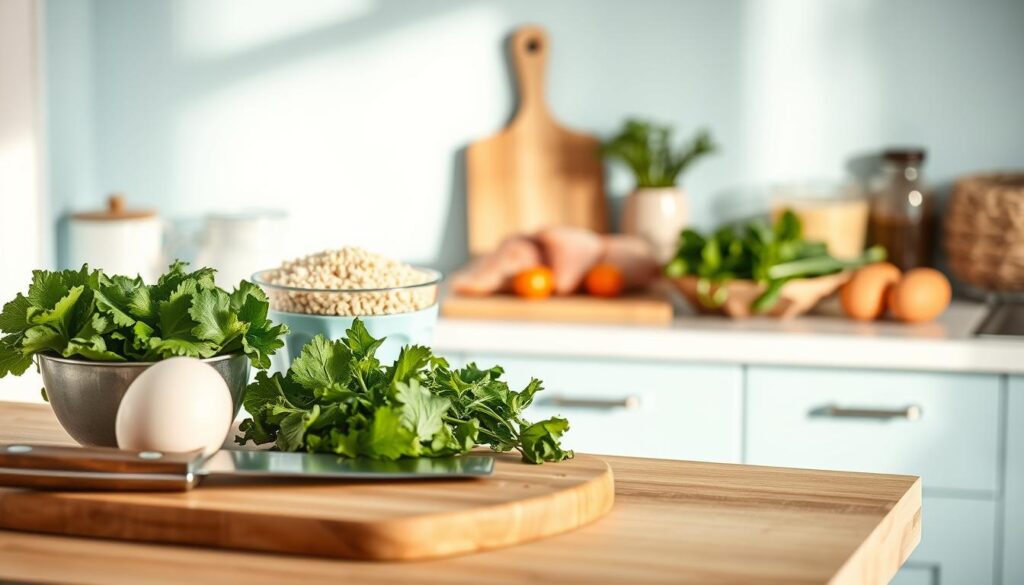
Shop strategically: grab pre-cut veggies to save time, and opt for frozen shrimp (thaws fast) or canned beans. One client’s freezer burritos—filled with black beans and scrambled eggs—became her family’s grab-and-go breakfast hero all month.
Streamlined Cooking and Assembly Techniques
Cook proteins and grains simultaneously. Roast chicken thighs while quinoa simmers, then air-fry tofu cubes. Use an assembly-line approach: portion bases (rice, greens), add proteins, then top with sauces. Studies show this method cuts active cooking time by 35%.
For muscle recovery, pair grilled salmon with sweet potatoes—it delivers 30g of protein and complex carbs. Track your daily intake using portioned containers labeled with grams. A gym regular in our community credits this system for his consistent energy during afternoon workouts.
Remember: Your morning meal sets the tone. Whip up Greek yogurt parfaits with nuts during prep day—it’s a breakfast that fuels both busy parents and office warriors. Keep dressings separate until serving to maintain crunch and freshness.
Customizable Meal Options for Lunch and Beyond
Last week, a mom from Raleigh shared how she feeds her vegetarian teen and meat-loving husband using the same core ingredients. Her secret? Treating recipes like choose-your-own-adventure templates rather than rigid rules. This flexibility lets you honor different needs while keeping your kitchen sane.
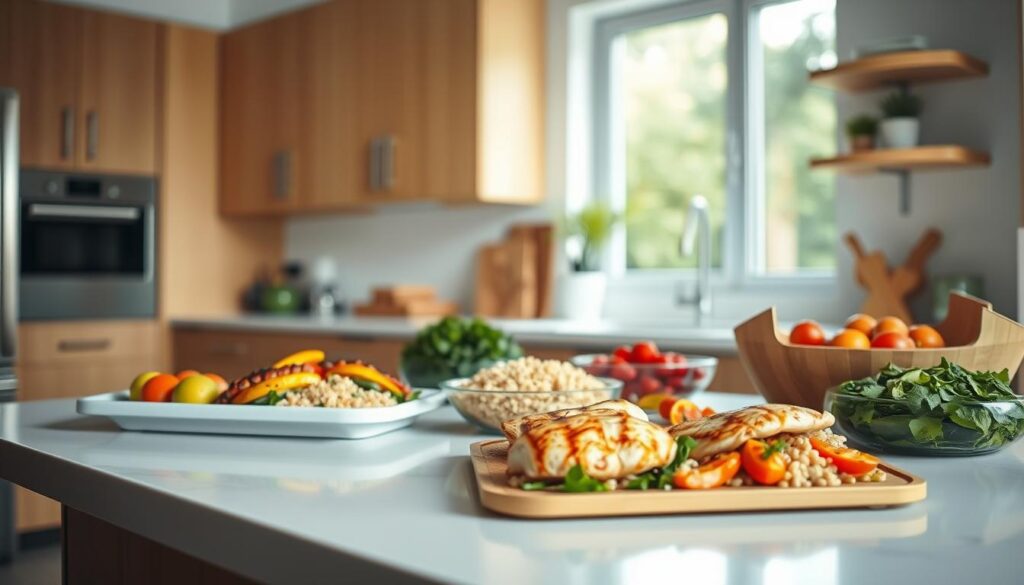
Vegetarian, Vegan, and Meat-Based Choices
Start with plant-powered stars like spiced chickpeas (15g protein per cup) or marinated tempeh. These become wraps, grain bowls, or taco fillings. For meat lovers, batch-grill chicken thighs or turkey patties—they’ll work in salads or sandwiches all week.
Swapping ingredients keeps flavors fresh. Try these simple switches:
- Greek yogurt → mashed avocado (vegan)
- Ground beef → lentils (vegetarian)
- Cheese → nutritional yeast (dairy-free)
One reader’s salmon teriyaki bowls morphed into tofu stir-fry by Thursday. “My family didn’t notice the protein swap,” she laughed. This freezer-friendly approach works for all diets—just label containers clearly.
Your body thrives when meals match its needs. A CrossFit enthusiast might pair quinoa with steak, while an office worker prefers chickpea salads. Both get 25g+ protein per serving. The key? Prep food at home your way—roast veggies Sunday, then build meals as you go.
This system adapts to every part of your weekly plan. Monday’s taco filling becomes Wednesday’s stuffed peppers. Friday’s grilled shrimp? Toss them into next week’s pasta. When you control ingredients, you create flavorful food that fuels your body and your schedule.
Incorporating Additional Nutrient-Rich Recipes
Last winter, a client texted me a photo of her counter—six cookbooks open to different pages, overwhelmed by recipe overload. We simplified her plan with two powerhouse dishes: miso-glazed salmon and Moroccan chickpea stew. These became her gateway to exploring flavor-forward nutrition without kitchen chaos.
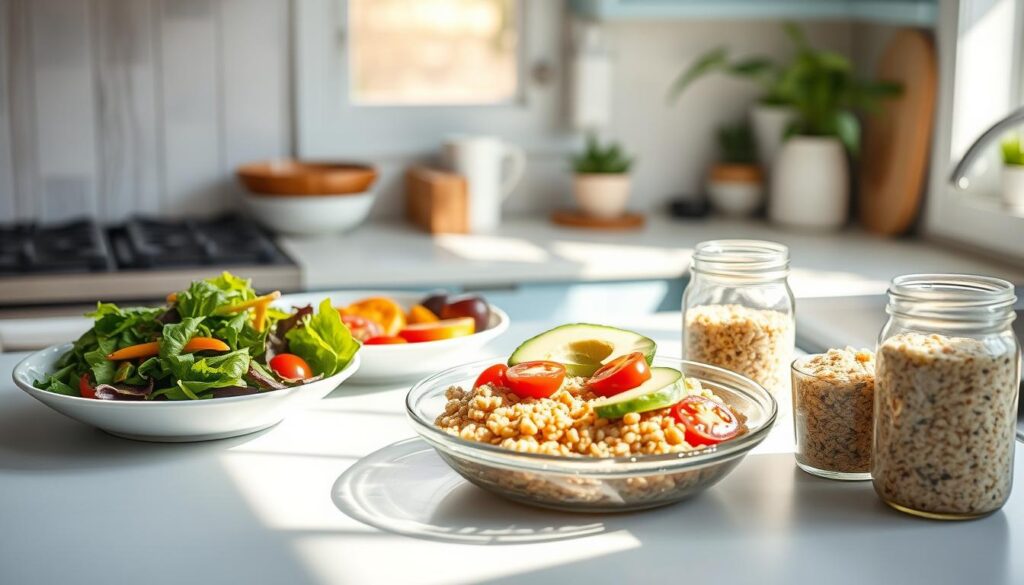
The salmon delivers omega-3s and 22g of protein per 4-oz portion. Marinate fillets in miso paste mixed with rice vinegar—it takes three minutes, then bakes while you prep sides. Pair with quick-pickled veggies for gut-friendly crunch. Benefits? Steady energy through afternoon meetings and faster post-workout recovery.
The stew combines chickpeas (14g protein/cup) with sweet potatoes and spinach. Simmer a double batch Sunday—it freezes beautifully for busy weeks. One reader told me this became her toddler’s favorite “orange soup,” proving kid-friendly and nutrient-dense aren’t mutually exclusive.
Integrate these options into your routine:
- Portion stew into 1½-cup servings with cooked quinoa
- Use leftover salmon in grain bowls or low-calorie dishes
- Swap spices weekly (try smoked paprika or turmeric)
Your kitchen becomes a nutrient hub when you focus on versatile base recipes. Roast extra veggies during prep day—they’ll top salmon Tuesday and blend into stew Thursday. This approach keeps meals exciting while hitting daily vitamin and mineral targets effortlessly.
Creating a Balanced Shopping List for Protein Meal Prep
Last Thursday, a regular at our Asheville farmers’ market confessed she’d abandoned three grocery carts mid-shop this month. “I either forget essentials or buy random items that rot,” she sighed. Let’s fix that with a strategic list that works smarter—not harder—for your nutrition goals.
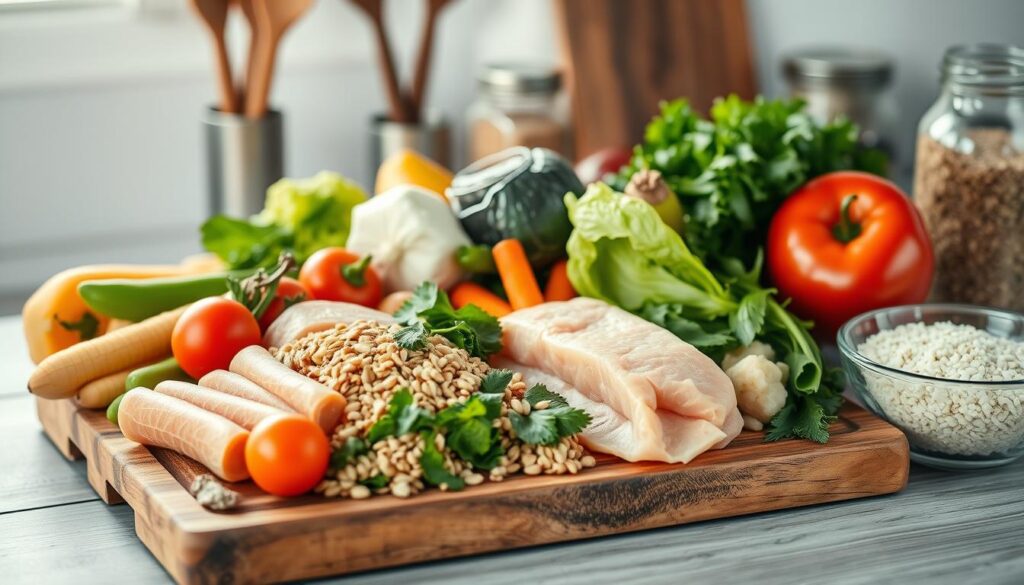
Essential Pantry and Fresh Produce Items
Build your list around three pillars: foundation proteins, flavor-packed veggies, and smart staples. For weight loss support, prioritize items delivering 20+ grams protein per serving:
- Proteins: Chicken thighs (24g/serving), black beans (15g/cup), Greek yogurt (17g/container)
- Veggies: Spinach (frozen for smoothies), bell peppers (pre-chopped saves 15 mins), broccoli florets
- Grains: Quinoa (8g/cup cooked), whole wheat tortillas (6g each)
Shop sales strategically—stock up on shelf-stable items like canned tuna when discounted. One client’s “protein pantry” system lets her assemble meals in 10 minutes using stored lentils and frozen shrimp.
Track inventory with a whiteboard on your fridge. Circle items needing replenishment during weekly planning. This method helped a busy dad cut his grocery trips from four to two weekly while reducing food waste by 30%.
Remember: Your list should work for your schedule. Batch-buy family packs of chicken, then freeze individual portions. Need quicker options? Rotisserie chicken offers 25 grams protein per serving—shred it for wraps or grain bowls instantly.
Time-Saving Techniques and Freezer-Friendly Tips
One client’s “aha moment” came when her freezer stash powered three weeks of meals during back-to-school chaos. “I finally stopped stressing about daily cooking,” she told me. Smart batch cooking and storage turn your freezer into a flavor-preserving ally—here’s how to make it work.
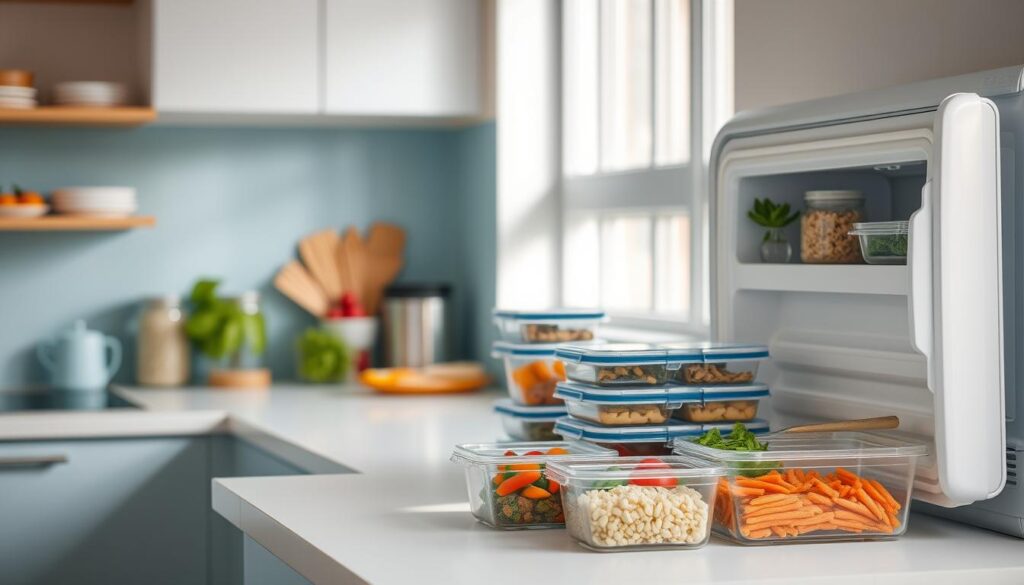
Batch Cooking Strategies
Cook once, eat thrice: Roast two sheet pans of veggies while your Instant Pot simmers lentils. Portion into 1-cup containers for grab-and-go salads. For 20-minute burritos, mix scrambled eggs with black beans and a scoop of unflavored powder—wrap in foil, freeze, then microwave straight from frozen.
My Sunday ritual? Triple batches of turkey meatballs (bake, then flash-freeze on parchment). They’ll become pasta toppers, sandwich fillers, or soup add-ins. This approach ensures consistent protein intake without weekday cooking marathons.
Efficient Freezer Storage Methods
Label everything: “Chili 3/12” beats guessing games. Use ½-cup silicone molds for sauces—pop out frozen cubes into zip bags. Store soups flat in gallon bags to stack like books. A teacher client organizes her freezer by meal type: “Breakfast pockets front-left, dinner stews back-right—I can grab blindly at 6 AM.”
For optimal texture:
- Cool foods completely before freezing
- Remove excess air from containers
- Thaw overnight in fridge compartments
These methods protect your daily protein goals while freeing time for what matters. Next time you update your shopping list, add freezer-safe containers—they’re the unsung heroes of stress-free meals.
Conclusion
Imagine opening your fridge to find meals that fuel your week without daily cooking. This method turns that vision into reality—no perfection required. By focusing on strategic planning and versatile ingredients, you’ll create nourishing options that adapt to changing schedules and tastes.
Start with a well-organized list and dedicate one afternoon to prepping basics. Roast veggies, batch-cook proteins, and mix dressings. These steps become your toolkit for building meals that support energy levels and loss goals. Parents and professionals alike report fewer stressful days when lunches are ready in minutes.
Remember: Success lies in simplicity. Swap components freely—turn Monday’s grilled chicken into Wednesday’s curry bowl. A teacher in our community dropped 14 pounds by sticking to her list, while a nurse streamlined her family’s meals using frozen ingredients.
Ready to reclaim your lunchtime? Grab containers, pick three recipes from this guide, and prep your first batch. Share your wins (and funny fails!) with our cooking community. Your journey to stress-free nourishment starts now.

